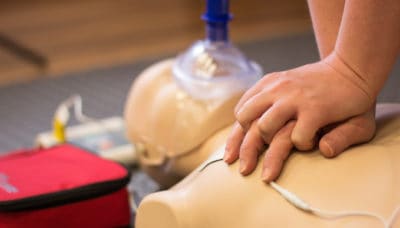Introduction
In today's busy work environment, safety and security is vital. Organizations are progressively recognizing the importance of developing a risk-free room for staff members. Among one of the most crucial components of office safety training is first aid and mouth-to-mouth resuscitation (Cardiopulmonary Resuscitation) training courses. These training courses not just empower workers with important life-saving skills however additionally cultivate a culture of safety and security within the organization. In this article, we will explore the myriad reasons why office security training need to include emergency treatment and CPR programs, emphasizing their relevance in boosting work environment safety.
Why Workplace Safety and security Training Should Consist Of First Aid and CPR Courses
https://jsbin.com/locaqulomaThe assimilation of first aid and CPR courses into workplace security training has significant benefits. They equip employees with the understanding and skills needed to respond efficiently to medical emergencies, reduce recovery time for injured people, and potentially conserve lives. Additionally, having actually educated employees on-site can infuse self-confidence amongst employees and reassure them that their wellness is prioritized.
Understanding Initial Aid
First aid describes the prompt treatment given to an individual struggling with a minor or severe health problem or injury till specialist clinical assistance shows up. Understanding basic emergency treatment concepts can make a significant difference in emergency situation situations.
Key Components of First Aid
Assessment: The ability to analyze a situation swiftly can aid determine the proper activities needed. Stabilization: Understanding exactly how to stabilize a hurt individual stops more harm. Communication: Effectively communicating with emergency situation solutions is critical for timely assistance.The Importance of CPR
CPR is a life-saving strategy used in emergencies when somebody's heartbeat or breathing has stopped. It includes chest compressions and rescue breaths to maintain blood flow and oxygenation up until professional aid arrives.
How mouth-to-mouth resuscitation Works
- Chest Compressions: These help distribute blood throughout the body. Rescue Breaths: These offer oxygen to the lungs.
Benefits of Emergency treatment and CPR Certification
Obtaining a first aid certificate or finishing mouth-to-mouth resuscitation programs features various benefits, both for people and organizations.
Enhanced Employee Confidence: Employees really feel more safe understanding they have life-saving skills. Reduced Recuperation Time: Quick action through first aid can lead to better results for injured individuals. Compliance with Regulations: Many industries require licensed workers as part of their health and wellness regulations.Creating a Society of Security Through Training
Implementing emergency treatment and CPR training promotes a culture that prioritizes employee health.
Encouraging Teamwork
Training sessions often include team-building workouts that boost cooperation amongst employees.

Building Count on Between Workers and Management
When monitoring purchases staff member training, it shows dedication to their health and wellness, resulting in boosted morale.
First Help Flows vs. CPR Courses: What's the Difference?
While both types of training courses are important, they concentrate on various skill sets.
First Aid Courses
These programs cover a vast array of subjects beyond simply cardiac emergency situations, consisting of:
- Wound care Burns Choking
CPR Courses
CPR programs specifically focus on techniques associated with cardiac arrest situations, highlighting:
- Adult CPR Child/ infant resuscitation Use of an Automated External Defibrillator (AED)
Choosing the Right Training Provider
Not all training carriers are produced equivalent; for that reason, choosing one that meets your organization's requirements is critical.
Accreditation Matters
Ensure that your picked company uses approved courses recognized by relevant authorities.
Instructor Experience
Consider teachers' credentials; skilled instructors usually provide richer discovering experiences via real-world examples.

Incorporating Emergency treatment into Office Safety Policies
Organizations must incorporate first aid demands into their more comprehensive safety and security plans for detailed coverage.
Regular Training Updates
Conducting routine refresher courses ensures that knowledge remains current among employees.
Creating Emergency Feedback Plans
Having clear plans in position can guide experienced workers during emergencies.
Legal Ramifications of First Aid Training in the Workplace
Employers have legal obligations relating to workplace security; implementing first aid training can aid reduce risks connected with non-compliance.
Negligence Claims
Failure to give appropriate training might leave companies susceptible to legal actions if an incident occurs because of lack of preparedness.
FAQ Section
What is consisted of in a typical emergency treatment course?- A regular first aid course consists of instruction on examining injuries, dealing with wounds, taking care of burns, taking care of choking events, and doing CPR if necessary.
- Most CPR programs last between 4-- 6 hours depending upon whether it's standard or advanced training.
- While not always legally mandated, having licensed team member can dramatically enhance work environment security standards.
- Many recognized companies offer on the internet renewal choices for emergency treatment certificates that include evaluations by means of video clip conferencing.
- Yes, markets such as building and construction, health care, education, and production frequently have regulative demands requiring trained workers on site.
- It's recommended that staff members join correspondence course every 2 years or earlier if there are considerable changes in treatments or regulations.
Conclusion
To summarize, integrating emergency treatment and mouth-to-mouth resuscitation right into work environment safety training is not simply a choice yet a necessity in today's workplace where emergencies can occur at any moment. Organizations benefit greatly from having actually trained employees prepared to react properly during crises while fostering an ambience where staff member health takes priority over all else. Consequently, it comes to be HLTAID012 Child Care training program noticeable why work environment safety and security training must consist of first aid and CPR programs-- they conserve lives while promoting an aggressive approach toward health and wellness criteria within organizations throughout various sectors.
By focusing on such necessary training campaigns-- emergency treatment certificates obtained through reputable companies along with sensible hands-on experience-- firms can significantly improve their total emergency readiness degrees while additionally constructing more powerful teams with the ability of taking on any type of scenario head-on!
